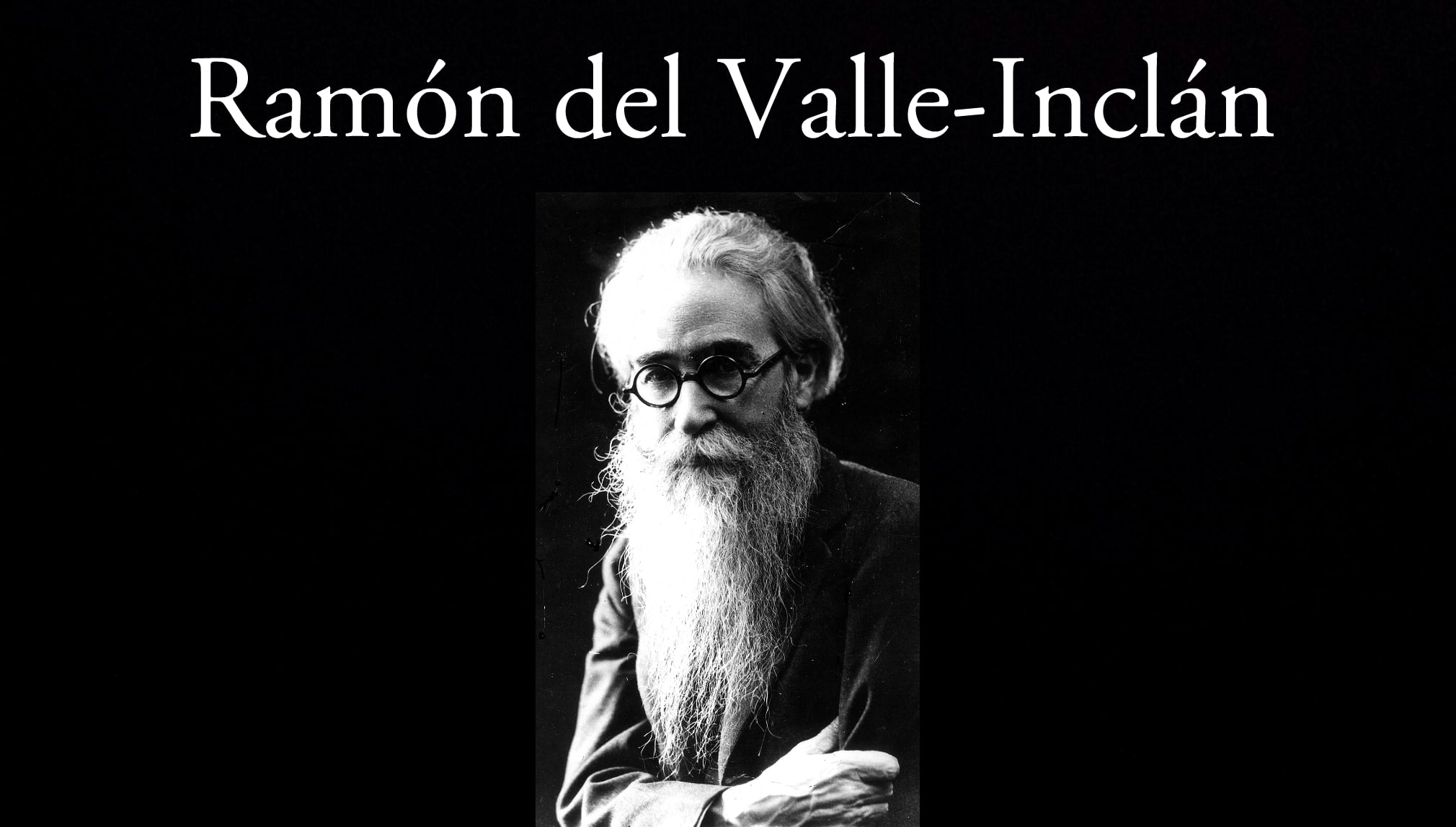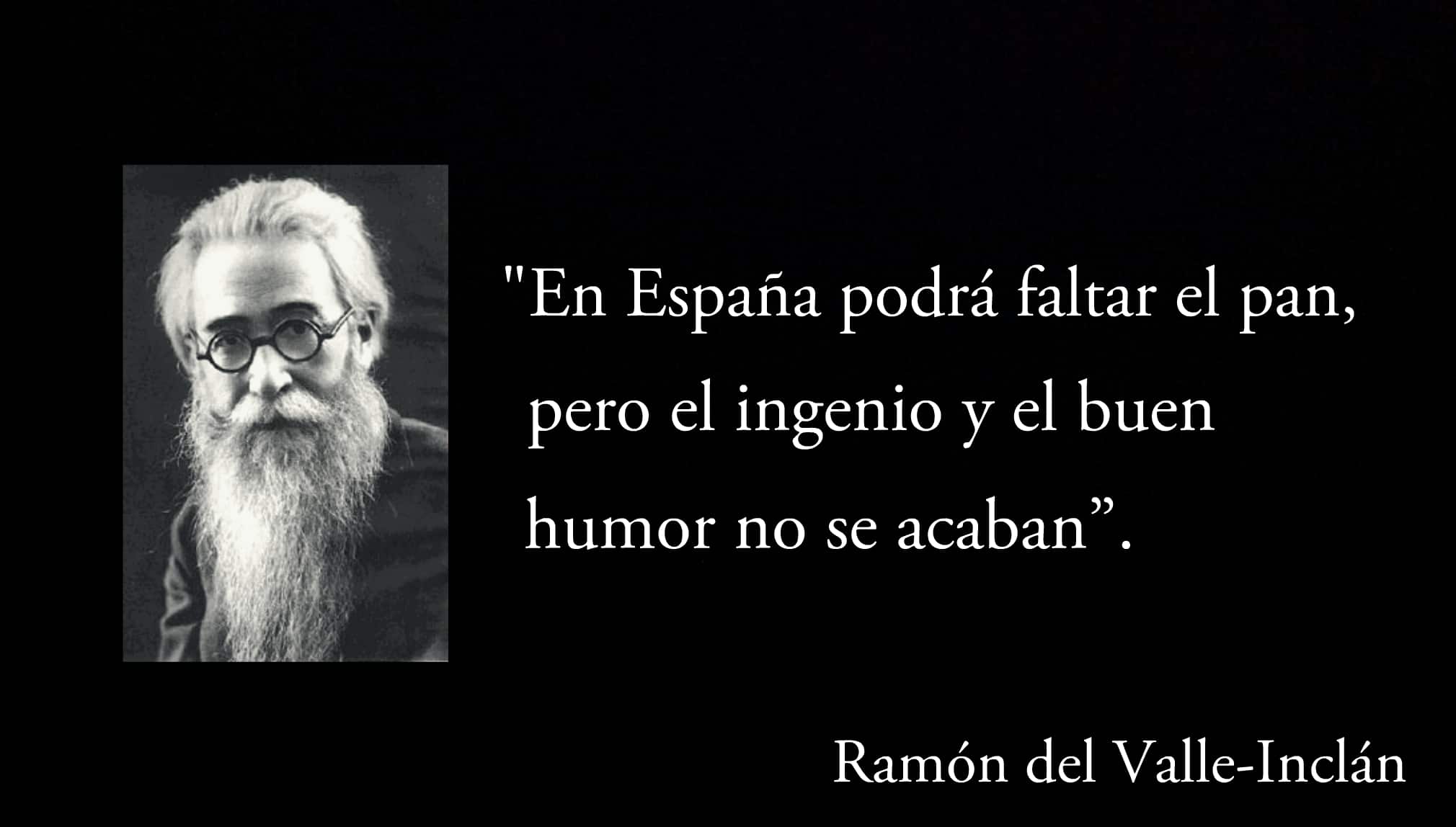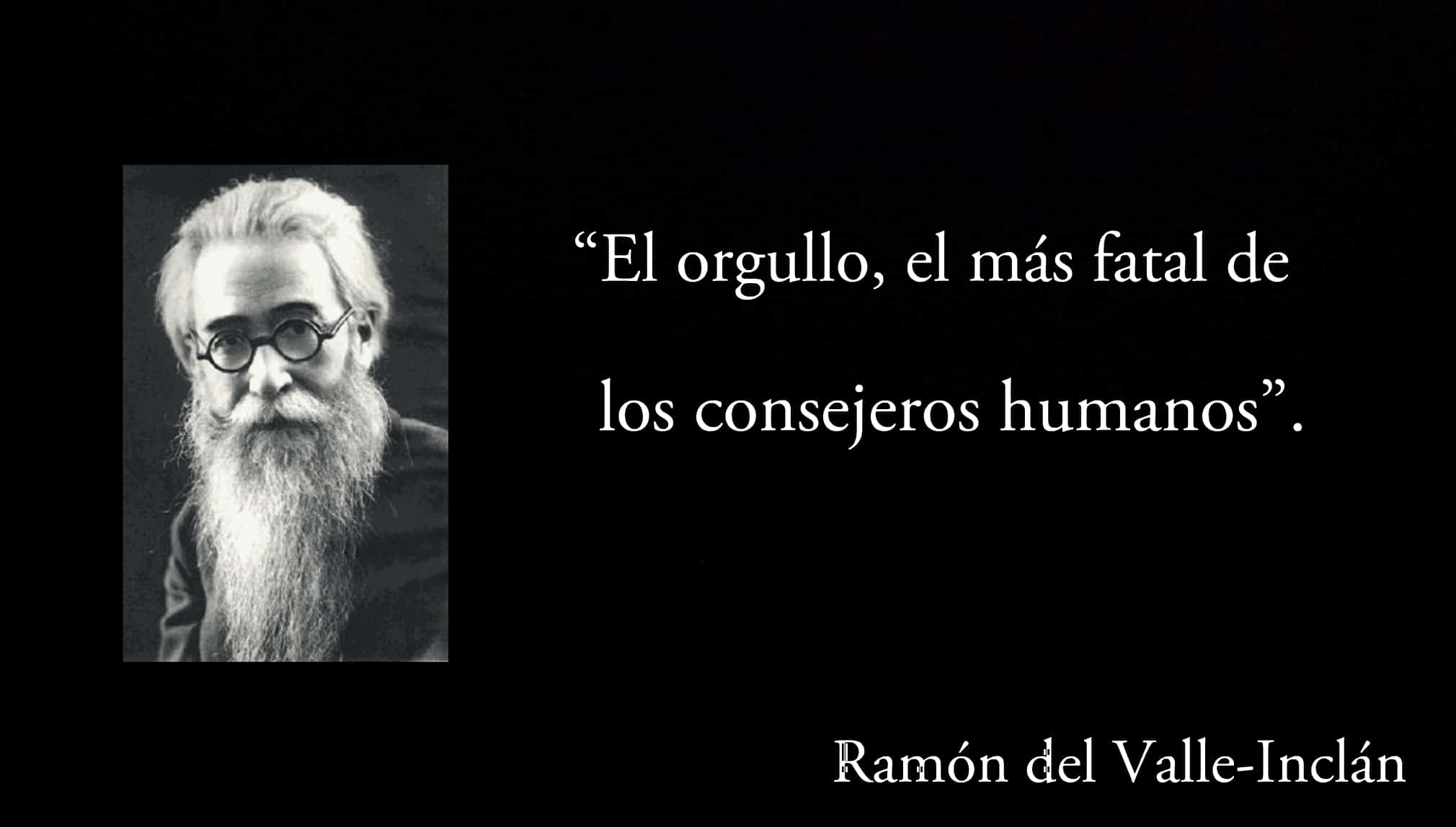
Ramon del Valle-Inclan.
Ramón José Simón Valle y Peña was a prolific Spanish playwright, poet and novelist. He is considered one of the neuralgic figures of 98th century Spanish literature, was part of a current called Modernism and is one of the most representative authors of the Generation of XNUMX. During various periods of his life he also worked as a journalist, short story writer and essayist .
In reality, his university training was in law — a career with which he never felt completely comfortable.. Consequently, he dropped out of school just after his father's death in the early 1890s. It would be the starting point of a bohemian existence, focused on literature and filled with trips that included numerous anecdotes such as a visit to the French front during the Great War. or the loss of an arm in a fight.
Biography
Valle-Inclán's biography is worthy of making a movie.
Birth, childhood and adolescence
His full name, Ramón José Simón Valle y Peña, only appears on the christening certificate. He was born into a noble family on October 28, 1866, in Villanueva de Arosa (Province of Pontevedra). He was the second child from the second marriage of Ramón del Valle Bermúdez with Dolores de la Peña y Montenegro, both heirs of various properties that were dwindling due to the father's waste.
Little Ramón was assigned to the tutelage of Carlos Pérez Noal, the cleric of Puebla del Deán. In 1877 he entered the Institute of Santiago de Compostela as a free student.There, he studied high school until he was 19 years old without showing much interest. However, during that time the influence of Jesús Muruáis was very relevant for his later literary training.
Youth, influences and studies
In September 1885 - at the imposition of his father - he began his law studies at the University of Santiago together with his brother Carlos.. In Compostela his apathy for studies was very evident, not so for other idle habits such as games of chance and social gatherings where he cultivated friendships with promising Galician intellectuals, among them Vázquez de Mella, Enrique Labarta, González Besada and Camilo Bargiela.
Passion for the Italian language and fencing
He also learned fencing and Italian thanks to his close relationship with the Florentine Attilio Pontarani. In 1877 he was exempted from military service. A year later he enrolled in the School of Arts and Crafts within the Drawing and Figure Adornment course, becoming one of the most popular students.
Early writings
At that time he published his first writings in the magazine Coffee with drops of Santiago de Compostela and began to become more actively involved in journalism in the region. The visit of a consecrated José Zorrilla to the University of Santiago leaves in the young Ramón “the bug” of the literary vocation more current than ever… it was only a matter of time. In 1890 his father died and he was free from family obligations.
Return to Pontevedra and transfer to Madrid
After five years of brief unfinished studies, he returned to Pontevedra before settling for two years in Madrid (with a brief visit to Italy). In the Spanish capital he is becoming known among the gatherings of the numerous cafes of Puerta del Sol due to his overwhelming personality and wit.
At that time, he has yet to build a solid reputation as a writer. With much effort, he managed to participate in some journalistic collaborations towards the end of 1891 for newspapers such as The balloon y The Iberian Enlightenment, in which, he signs for the first time under the name "Ramón del Valle-Inclán". His artistic surname was adopted from Francisco del Valle-Inclán, one of his paternal ancestors.
Trip to Mexico
But the income obtained was not enough to ensure lasting economic stability. For this reason, Valle-Inclán decides to travel to Mexico in search of new opportunities. He landed in Veracruz on April 8, 1892; a week later he settled in Mexico City and began working as a translator for Italian and French for newspapers such as The Spanish Post, El Universal y The independent Veracruz.
It was a period of adventures and important growth in the midst of the oppression and censorship imposed by President Porfirio Díaz. From his friendship with Sóstenes Rocha he obtained a very complete overview of Mexican politics and was inspired by many of the stories later exposed in Female. Valle-Inclán closed his first stay in the Aztec country at the end of 1892, when he set sail for Cuba.
First publications
During the spring of 1893, the histrionic, bearded and hairy Valle-Inclán returned to Pontevedra. There, he established a very close friendship with Jesús Muruáis and René Ghil. In 1894 he published his first book, Female (Six love stories). By now, young Ramón has fully assumed his profession as a writer. From that moment his entire life revolved around literature and the arts.

Phrase by Ramón del Valle-Inclán.
Return to Madrid and other publications
In 1895 he returned to Madrid; He worked as a public official in the Ministry of Public Instruction and Fine Arts. He became famous in the many Madrid cafes of that time due to his particular accent, his ability to dominate conversations, destroy reputations and explosive character, which led him to heated discussions with personalities such as Pío Baroja or Miguel de Unamuno.
During 1897 his second book was released, Epitalamio (Love stories), a complete editorial failure. The ruling was so great that Valle-Inclán seriously explored the option of changing professions and becoming an interpreter. In 1898 and 1899 he played roles of various kinds in theatrical works The comedy of the beasts by Jacinto Benavente and in The kings of exile by Alejandro Sawa, respectively.
Meeting with Rubén Darío and his hardships at the end of the century
During the spring of 1899 the economic difficulties were obvious, he even went hungry. Even so, Valle-Inclán was still controversial in some opinions (in favor of the independence of Cuba, for example). To survive, he needed to rely on his closest friends, Rubén Darío being one of his most unconditional.
In the summer of that year there was an important incident at the Café de la Montaña, where was injured in the head and arm after an argument with the writer Manuel Bueno. Ramón neglected the injury, consequently, it resulted in a very aggressive gangrene and the amputation of his left limb.
Occasionally performed translations and adaptations for the Spanish State (The face of god from Arniches, for example) to earn some money. In 1901 he accidentally shot himself in the foot during a trip to La Mancha. Convalescing, he was inspired to create Autumn Sonata, published in 1902 as the opening of the Memoirs of the Marquis of Bradomín, in the weekly Impartial Mondays.
Maturity and marriage
Since then he adopted an editorial strategy based on advancements in press releases until the end of his days before launching his books.. In the following years he published Summer Sonata (1903) Spring sonata (1904) and Winter Sonata (1905), the latter dedicated to his future wife, the actress Josefa María Ángela Blanco Tejerina. At that time he was already recognized as a prominent representative of Spanish Modernism.
The Marquis of Bradomín was finally premiered at the Princess Theater (1906), arousing great admiration among the public and the press. In 1907 he presented his first barbaric comedy in Barcelona, Blazon Eagles. He also released several books: Scents of legend, Verses in praise of a holy hermit, The Marquis of Bradomín - Romantic talks y Romance of Wolves.
He married Josefa Blanco in August 1907, with her he had six children: María de la Concepción (1907), Joaquín María (1919 - died a few months after birth), Carlos Luis Baltasar (1917), María de la Encarnación Beatriz Baltasara (1919), Jaime Baltasar Clemente (1922) and Ana María Antonia Baltasara (1924). Although the couple tried to settle in Galicia, they spent most of the next fifteen years in Madrid.
Ramón and his wife began a six-month Spanish-American tour in 1910 with the Francisco Ortega García theater company. through Argentina, Chile, Bolivia, Paraguay and Uruguay. Likewise, Valle-Inclán continued to launch plays in Spain, such as Gesture voices (1911) The Marchioness Rosalinda. Sentimental and grotesque farce (1913) and Wonderful lamp. Spiritual exercises (1915, first volume of The works).
Participation in World War I
The death in Nicaragua during 1916 of his great friend Rubén Darío greatly affected Valle-Inclán. That same year the Great War had one of its highest points. Although opinions in Madrid were divided, Valle-Inclán made his position clear in his < >. By this text the government of France invited him to visit the war fronts of Alsace, Flanders, Vosges and Verdun.
Equally, Between April 27 and June 28, 1916 Ramón Valle-Inclán served as a war correspondent for The Impartial, where he published the series of writings Midnight Star Vision (October - December 2016) and In the daylight (January - February 1917). Additionally, he held the position of professor of Aesthetics of Fine Arts at the Special School of Painting and Engraving of Madrid from 1916.
The "grotesque", health problems and second trip to Mexico
In 1919 he released his second poetic book, Kif's pipe y The village tragicomedy (newspaper bulletin The Sun). During 1920 Ramón presented his third poetry text, The passenger, Divine words y Bohemian lights, the first "grotesque" published between July and October (series of thirteen brochures) in the magazine Spain. The second grotesque, The horns of Don Frijolera, appeared in The pen between April and August 1921.
According to Javier Serrano from the University of Santiago, “The grotesque marks the most significant moment in the artistic creation of Valle-Inclán, and represents the most complex and successful step of Spanish literature in the European work of literary renewal of the XNUMXth century. The grotesque is configured as an intricate system of interpretation of reality, which is officially fictionalized, in order to dismantle the false image that one has of one's own existence… ”.

Phrase by Ramón del Valle-Inclán.
Valle-Inclán himself defined that his main motivation in creating the grotesque was "Searching for the comic side in the tragedy of life". Probably, his delicate state of health had a great influence on the essence of this literary creation, since he needed a surgical intervention to extract a tumor in his bladder (it will be a condition that will accompany him until his death).
At the beginning of the summer of 1921 Ramón Valle-Inclán traveled to Mexico, invited by President Álvaro Obregón, due to the celebration of the centenary of independence. After an agenda full of cultural activities, he stayed two weeks in Havana and another two in New York, before returning to Galician lands in December 1922.
Divorce, bankruptcy and last works
Starting in 1923, Valle-Inclán received multiple tributes in various print media in Spain and Latin America. At that time he began to write two of his masterpieces: Tyrant Flags (edition completed in 1926) and the series of Iberian Wheel (1926-1931). In 1928 he signed a sumptuous contract with the Ibero-American Publications Company (CIAP), which gave him some economic comfort on a temporary basis.
However CIAP went bankrupt in 1931. Valle-Inclán was practically on the street, almost in a situation of destitution. Ultimately he agreed to work as general curator of the National Artistic Treasure (with limited duties). To add insult to injury, at the end of that year a divorce lawsuit filed by Josefina Blanco prospered (She only kept the youngest daughter, Ramón kept custody of the other three).
At the beginning of 1933 it had to be operated again in Madrid. A few months later he began to work as director of the Academy of Fine Arts in Rome, although he was quickly discouraged due to the dilapidated state of the institution's building coupled with the heap of bureaucratic procedures necessary to change the situation.
In 1935 his bladder problems worsened. Therefore, he decided to return to Galicia for treatment, as well as surround himself with admirers, family and friends. He tried to write again (he had not produced anything new for two years), but he was already very weakened. Ramón Valle-Inclán died on January 5, 1936, he left a huge legacy that made him worthy of the countless tributes made to date.